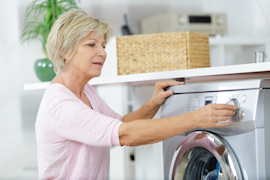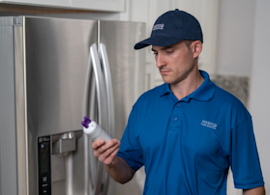How to avoid lint when washing clothes video


A clean, fresh-smelling pile of laundry can give you a warm, fuzzy feeling—unless those warm fuzzies are flecks of lint all over your clothes. This video shows how you can prevent that lint from forming in the washer with easy tips on how to sort clothes correctly, proper load size and why water temperature makes a difference.
See our DIY Washer Repair page for troubleshooting videos, step-by-step repair guides and tips on how to keep your washing machine running efficiently.
Tips on how to avoid lint on your clothes
Sort lint givers such as towels, flannel and sweatshirts from lint takers such as nylon, polyester and corduroy.
Don’t overload the machine. This can trap lint.
Check pockets for items such as tissues or paper, which can leave lint behind.
Keep water above 60 degrees and use the right amount of detergent. Water that’s too cold may not dissolve the detergent, which helps remove lint.
Select a wash cycle such as normal or delicate that spins clothes slower. High-speed or heavy-duty cycles can break down fabric fibers, causing more lint.
Most common symptoms to help you fix your washers
Choose a symptom to see related washer repairs.
Main causes: clogged drain hose, house drain clogged, bad drain pump, water-level pressure switch failure, bad control b…
Main causes: worn agitator dogs, bad clutch, broken motor coupler, shifter assembly failure, broken door lock, suspensio…
Main causes: bad lid switch or door lock, bad timer or electronic control board, wiring failure, bad water inlet valve a…
Main causes: broken lid switch or lid lock, bad pressure switch, broken shifter assembly, faulty control system…
Main causes: unbalanced load, loose spanner nut, worn drive block, broken shock absorber or suspension spring, debris in…
Main causes: no water supply, bad water valves, water-level pressure switch failure, control system failure, bad door lo…
Main causes: lack of electrical power, wiring failure, bad power cord, electronic control board failure, bad user interf…
Main causes: leaky water inlet valve, faulty water-level pressure switch, bad electronic control board…
Main causes: water heater failure, bad water temperature switch, faulty control board, bad water valve, faulty water tem…
Most common repair guides to help fix your washers
Effective articles & videos to help repair your washers
Use the advice and tips in these articles and videos to get the most out of your washer.

Find tips for using your washing machine efficiently to save energy and help reduce utility bills.…

Learn about all the convenient features on our Sears PartsDirect website that make your parts purchases easier.…

Get answers to frequently asked questions about Sears and Sears PartsDirect.…
